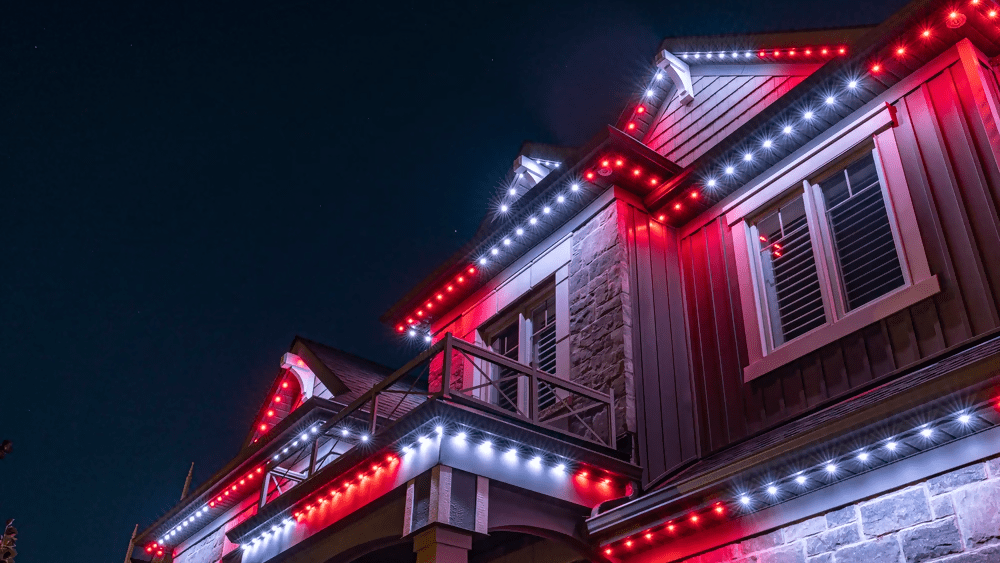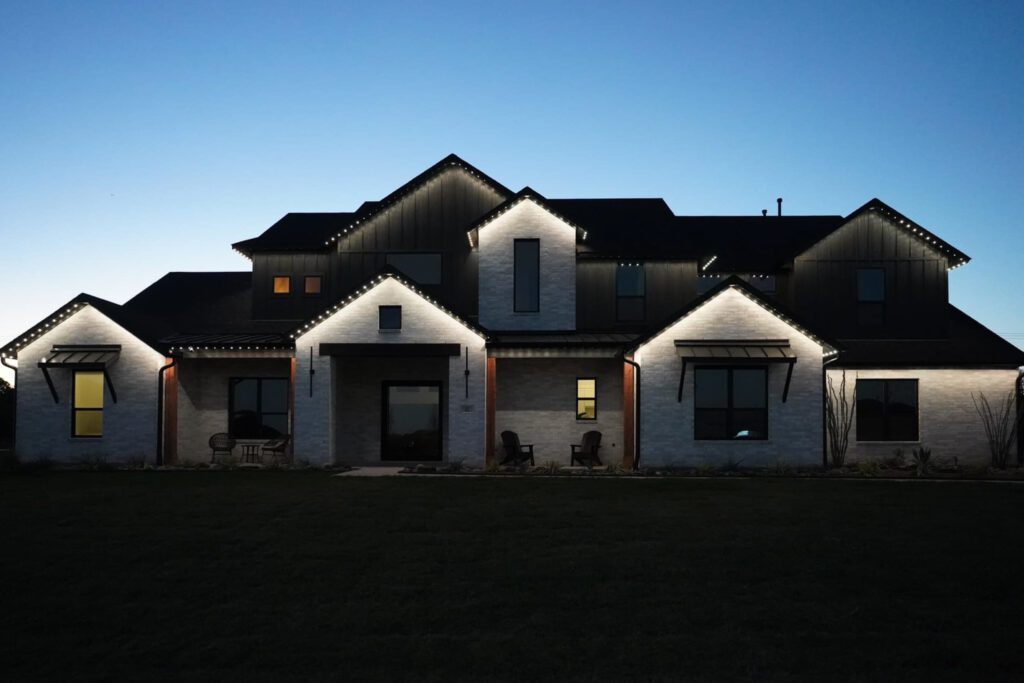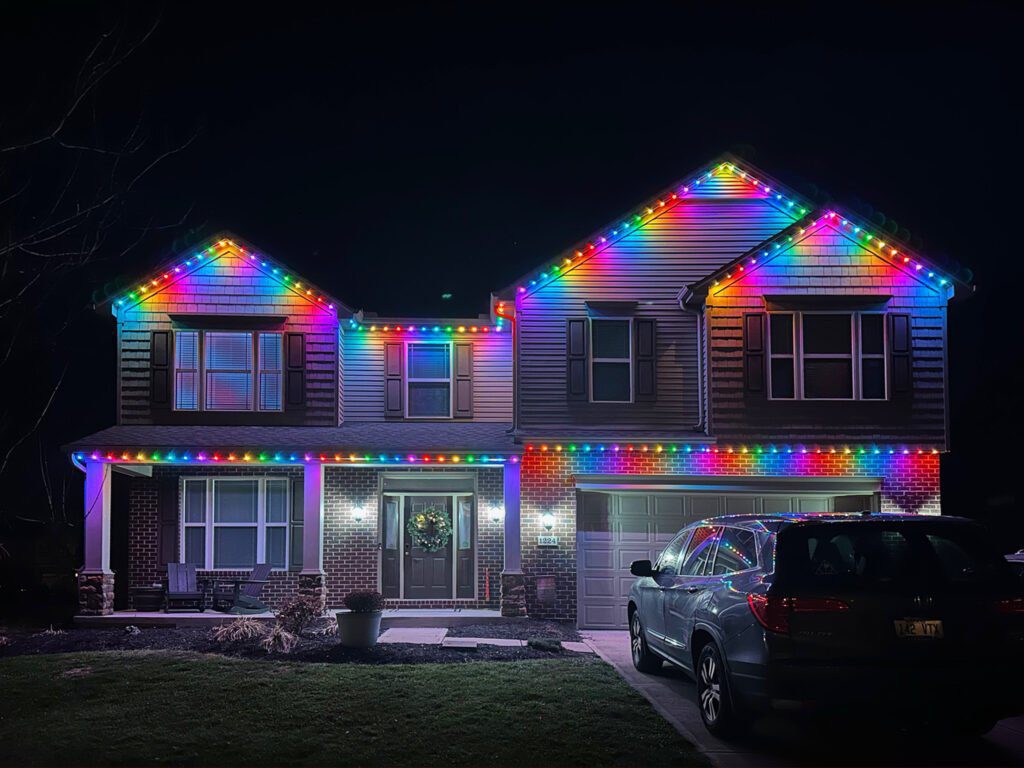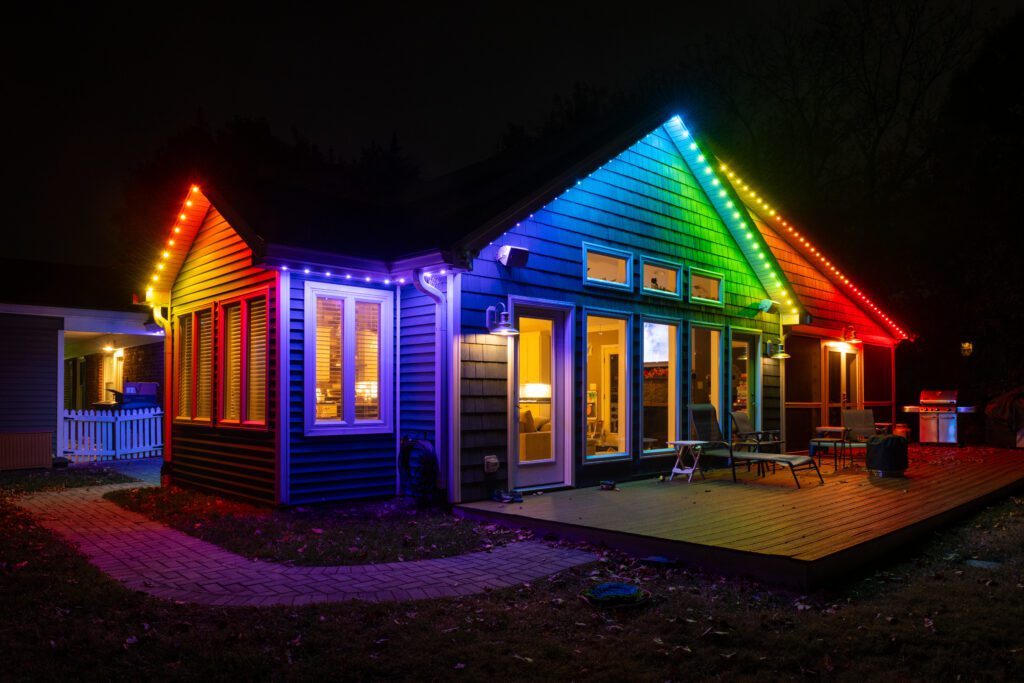Have you ever wondered if there is a better way to celebrate the holidays than spending hours on a ladder, hanging strings of lights that will only last for one season? If you are looking for a hassle-free, energy-efficient, and versatile alternative to traditional holiday lighting, you might want to consider permanent Christmas lighting. In this blog post, we will examine the cost and benefits of installing permanent lighting on your home, and compare some of the best brands available in the market.
What is permanent holiday lighting?
Permanent holiday lighting is a system of LED lights that are attached to your home’s exterior, usually along the roofline and other architectural features. Unlike regular holiday lights up, permanent lights are designed to withstand weather conditions and last for many years up to decades. They can be controlled by a smartphone app, allowing you to change the color, brightness, and pattern of the lights according to your mood or occasion. You can choose from millions of colors and create custom scenes for different holidays, seasons, or events.

What are the benefits of permanent holiday lighting?
One of the main advantages of permanent Christmas lighting is that it eliminates the need for traditional holiday lights, which can be costly, time-consuming, and risky. According to HomeAdvisor, the average cost of installing traditional holiday lights ranges from $200 to $1,000, depending on the size and complexity of the project. This does not include the cost of buying new lights every year, which can add up to hundreds of dollars over time. Moreover, installing traditional lights involves climbing ladders, handling electrical cords, and dealing with faulty bulbs, which can pose serious safety hazards. According to the U.S. Consumer Product Safety Commission, about 200 people per day are treated in emergency rooms for injuries related to holiday decorating during November and December.
Convenience: With permanent holiday lighting, you don’t have to worry about climbing ladders, untangling wires, or replacing burned-out bulbs every year. You can simply turn on your lights with a touch of a button or a swipe of your finger whenever you want.
Safety: Permanent holiday lighting eliminates the risk of falling from ladders, electrocuting yourself with faulty wires, or starting a fire with overheated bulbs. Permanent lights are also low-voltage and waterproof, making them safe for all-weather use.
Savings: Permanent holiday lighting can save you money in the long run by reducing your energy consumption and maintenance costs. Permanent lights use LED bulbs that consume only 1 watt per bulb, compared to 5 watts for incandescent bulbs. Additionally, permanent lights such as Oelo, have a lifespan of up to 100,000 hours, which means that they can last for 22 years if you use them for 12 hours a day. This means that you don’t have to buy new lights every year or pay for repairs.
Versatility: Permanent holiday lighting allows you to customize your home’s appearance with endless possibilities. You can choose from 16 million colors and create different scenes for different occasions. Schedule your lights with calendar timers for those memorable occasions or map out your luminary designs for the entire year. You can even use your permanent lights for other purposes besides holidays, such as security lighting or accent lighting.
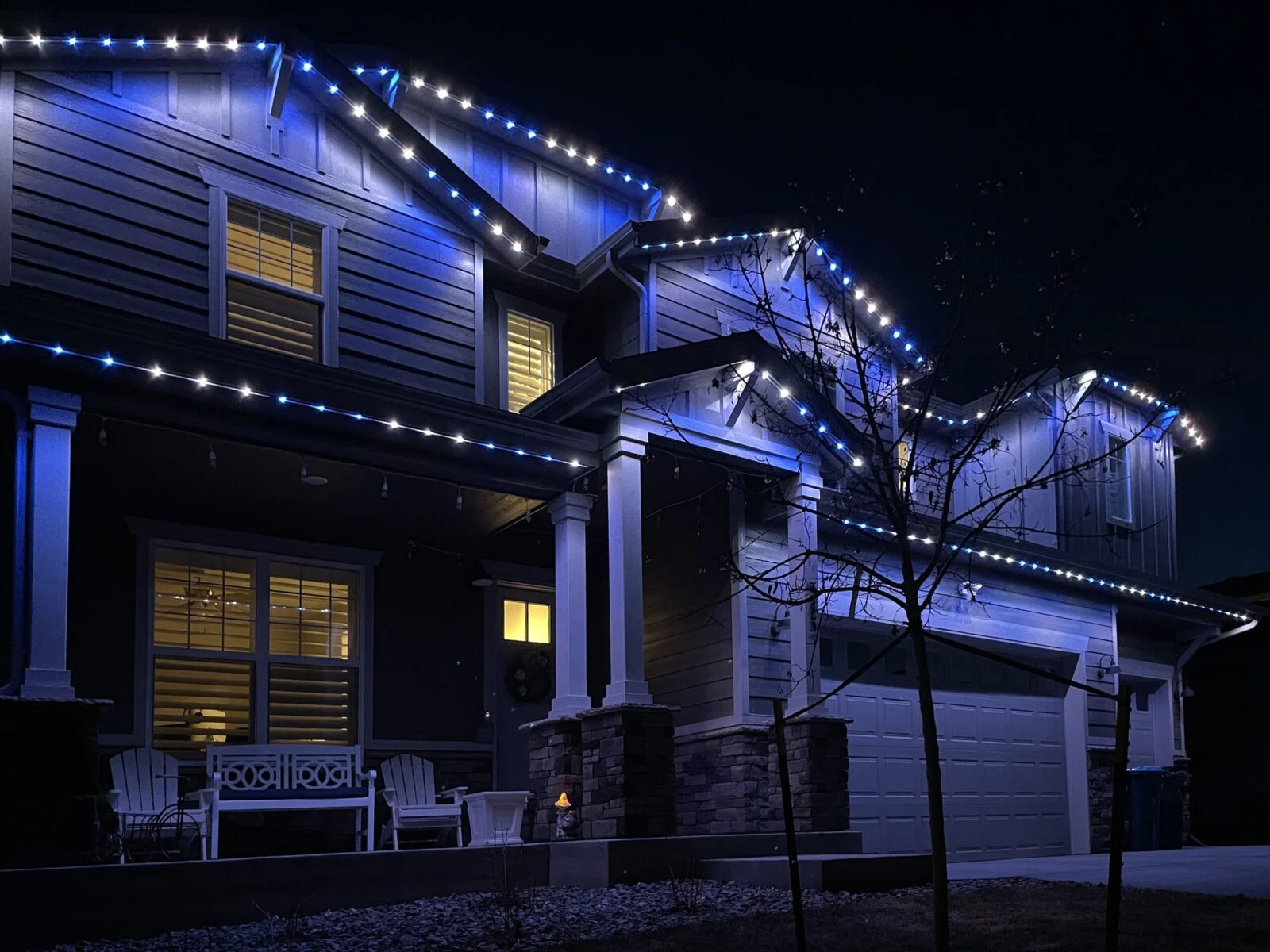
How much does permanent holiday lighting cost?
The cost of permanent Christmas lighting depends on several factors, such as the size of your home, the length of the light track, the complexity of the installation, and the brand of the lights. According to Leading Edge Decorative Lighting, a company that specializes in permanent lighting solutions in Arizona, the average cost of permanent lighting ranges from $17 to $22 per linear foot. This includes the cost of the light track, LED bulbs, control unit, and all the wiring and connections. However, this does not include the installation fee, which can vary from $5 to $12 per linear foot, depending on the difficulty and height of the project. For example, if you want to install 100 feet of permanent lighting on a single-story home, you can expect to pay between $2,800 and $3,800 for the materials and installation labor. If you want to install 200 feet of permanent lighting on a two-story home, you can expect to pay between $4,500 and $6,500.
While this might seem like a steep price to pay upfront, it is important to consider the savings potential over time. Permanent holiday lighting is much more energy efficient than traditional lights, as it consumes only 1 watt per bulb. For example, if you run a track lighting system for an average of 6 hours daily, your monthly electricity bill would increase by only $4 to $5. This means that you would spend only $50 to $60 per year on electricity for your permanent lighting system. In contrast, if you use incandescent lights for the same amount of time, your monthly bill would increase by about $40 to $50. This means that you would spend about $400 to $500 per year on electricity for your traditional lights. Of course, these calculations are based on some assumptions and averages, and your actual savings may vary depending on your usage, electricity rates, and other factors. However, they can give you a general idea of how permanent holiday lighting can save you money in the long run.
Additionally, permanent holiday lighting offers other benefits that are not easily quantified in monetary terms. For instance, permanent lighting saves you time and hassle by eliminating the need to put up and take down lights every year. This allows you to enjoy more quality time with your family and friends during the holidays. Furthermore, permanent lighting enhances the curb appeal and value of your home by giving it a unique and attractive look throughout the year.
| Oelo | Trimlight | Jellyfish | Gemstone | Everlights | |
|---|---|---|---|---|---|
| SYSTEM PRICE (Low $ - High $$$$$) | $$$ | $$ | $$$$$ | $$$$ | $ |
| LED LIFE VALUE (Hours of LED Life / Price) | ***** | *** | * | ** | ** |
| SYSTEM FEATURES VALUE (Features / Price) | ***** | *** | ** | *** | ** |
| DURABILITY VALUE (LED Housing, Weather Resistance, Ratings, etc / Price) | ***** | **** | ** | *** | * |
| RATINGS VALUE (Number of Safety Certifications & Patents / Price) | ***** | ** | * | **** | ** |
| WARRANTY VALUE (Warranty / Price) | **** | ***** | * | *** | ** |
What are some of the best brands of permanent holiday lighting?
Of course, not all permanent Christmas lighting systems are created equal. There are several brands on the market that offer different features and quality levels. If you want to get the best value for your money, you should do some research before making a purchase decision. One way to compare different options is to visit this comparison chart.
Some factors that you should consider when choosing a brand are:
Quality: The quality of the lighting system’s components such as light track, the LED bulbs, and the wiring affects the durability and performance of your permanent lights. You should look for brands that use high-quality materials such as durable tracks that are color matched to your exterior with a powder coating, have received UL-Listed certification on their LEDs and wiring, and offer a minimum of 5-year warranties.
Features: The features of the smartphone app affect the functionality and convenience of your permanent lights. You should look for brands that offer easy-to-use interfaces, a list of pre-set programs, and advanced options such as security lighting functionality.
Comparison: The comparison of different brands based on their price, quality, features, and customer reviews helps you make an informed decision. You should look for brands that have positive feedback and ratings from satisfied customers.
One source that provides a more comprehensive comparison of the three most popular brands in the permanent holiday lighting industry. This website compares Oelo, Jellyfish, and Gemstone, based on their pros and cons, specifications, and prices. According to this source, Oelo stands out as a leading brand due to its innovative technology, superior quality, longer lasting LEDs, and most durable low-profile light tracks. Here are just a few reasons why:
1. Oelo uses a patented low-profile light track that blends in with your home’s exterior and creates a seamless look. The light track is made of extremely durable aluminum (.04 thickness) or an acrylic design that can be used in more extreme weather elements. They both come in various colors to match your home’s style.
2. Oelo uses the industry’s highest quality LED bulbs that have a 100,000-hour runtime, which means that they can last for 22 years if you use them for 12 hours a day. Setting themselves apart, Oelo is the exclusive brand to attain an IP68 waterproof rating as well as a V-0 fire rating. For further insights into these ratings, click here. The LED bulbs are also dimmable and have a wide beam angle of 115 degrees, creating a uniform and bright illumination.
3. Oelo offers a cloud-based system with an easy-to-use smartphone app that allows you to control your lights from anywhere in the world. You can choose from 16 million colors and create custom scenes for different holidays, seasons, or events.
Conclusion
Permanent holiday lighting is a modern and innovative way to decorate your home for the holidays and other occasions. It has many benefits over traditional holiday lights, such as convenience, safety, durability, energy efficiency, and versatility. It also has the potential to save you money in the long run by eliminating the need to buy replacement lights every year and reducing your electricity bills.
However, permanent Christmas lighting also has a high upfront cost that may not be affordable or worthwhile for everyone. Therefore, before you decide to install permanent holiday lighting for your home, you should weigh the cost and benefits carefully and compare different brands and options available in the market.
If you have any questions or comments, feel free to leave them below or contact us anytime.
Note: This blog post provides a comparative analysis and is based on the information available at the time of writing. Product features and specifications may change over time, so it’s essential to refer to the official websites or consult with manufacturers for the most up-to-date information.

